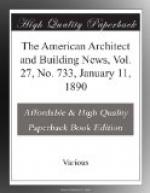From the same data we find (page 44) it stated that while the radiation through 25 m.m. of Wm. Berkefield’s fossil meal was 7.7 heat-units, through 25 m.m. of carb. magnesia it was 6.7 heat-units, therefore the proportions 7.7: 6.7 = $5.50: $4.80 gives us the coal value of heat lost by radiation through the magnesia covering. To put this in another form: From the running-foot of two-inch pipe uncovered the loss is 96 cents, while, from the same pipe covered with the magnesia, the loss is less than five cents; or a saving of over 91 cents per year. To accomplish this saving the cost of the covering should be taken into account. This was 27 cents. Therefore, the investment in the magnesia covering is paid back in less than four months. The data which we have used were obtained by the use of a calorimeter measuring the quantity of heat passing through covering. The other possible method of arriving at this knowledge would be to accurately measure the condensation of the steam. In these experiments, owing to several reasons, it was not deemed advisable to rely upon the second method. Recently, however, I have seen in the American Engineer of June 12, a report of the proceedings of the Michigan Engineering Society containing a paper by Professor Cooley, of Ann Arbor, Mich., in which he says:
“The benefits of covering steam-pipes to prevent radiation are strikingly illustrated by the following example: The Thomson-Houston electric-light plant in Ann Arbor has about 60 feet of seven-inch pipe connecting the boilers with the engines and two large steam-drums above the boilers: in March, 1887, the steam at the far end of this pipe was tested to determine the amount of entrained water, the pipes and drums at the time being uncovered. An average of nine experiments gave 31.01 per cent moisture. In June of the same year, after the pipes were covered with magnesia sectional-coverings, the quality of the steam was again tested, the average of five experiments giving 3.61 per cent moisture; the tests were made by the same men from the same connections, and in the same manner. The pipes and steam-drums in March were subjected to a draught, which, of course, aided the condensation. Enough water passed into the cylinders to retard the engines, producing a disagreeable noise. In June the weather was warmer and the pipes and steam-drums were well protected. The quality of steam at the boilers was tested in June, and showed about three per cent moisture. Assuming




